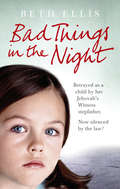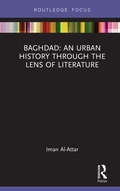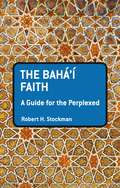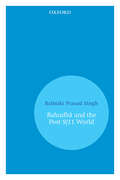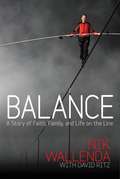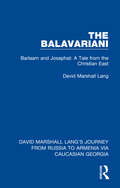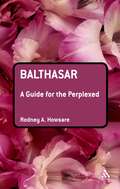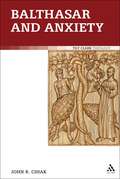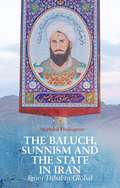- Table View
- List View
Bad Things in the Night
by Beth EllisA young girl at the mercy of her abusive stepfather and the religious community that protects him - Bad Things in the Night is a moving true story of pain and triumph.As a child Beth was imprisoned within a Jehovah's Witness family, kept away from her mother, forbidden from wearing a school skirt above her knees by day, abused by her stepfather at night. Years later, when she summons the courage to report her stepfather to the police for the first time, she is forced to relieve her childhood torment.Will Beth's fight for justice be worth the suffering reawakened?
The Badly Behaved Bible: Thinking again about the story of Scripture
by Nick PageWe're told that the Bible is beautiful, uplifting and a joy to read - but, while we know this is how we're supposed to feel about it, in reality many of us find the very opposite. On opening the Bible, we are faced with a multitude of problems; from its form and historical content to its sheer size and often distasteful stories, we can be left feeling overwhelmed and disheartened. But the problem is not with the Bible - and it's not with us either.The problem is we've been misinformed. And so, we end up believing things about the Bible that the Bible never claims for itself. But the Bible won't politely sign up to the neat categories and terms we force on it. That's why it's badly behaved. We want to control the Bible and tame it so that we can ride it into battle; but the Bible bucks and rears and throws us off. We want to pin the Bible down so that it proves our theology; but the Bible evades capture and plays hide and seek. We want answers; but the Bible keeps firing questions. We want it to tell us what to do; but the Bible keeps telling us to think. We want to make the Bible dance to our tune: but the Bible has music of its own. The Bible is an invitation and a call. The breath of God lifts its pages, and they rise and fall with his breathing.In his honest and accessible style, Nick Page urges us to re-discover a fresh look at the Bible as thescriptural bedrock of the Christian faith, to learn how we can undo unhelpful ways of reading it anddemystifying its purpose and scope.Nick tackles what the Bible is and what it isn't, how we can critically read this inspired text and how we approach the difficulties in its content.Alongside helpful analysis and practical advice - including kickstarting his one-man campaign to ban"Bible study" - Nick helps us re-discover how to rediscover the Bible as Holy Ground, as a place where we meet and encounter God.
Baghdad: An Urban History through the Lens of Literature (Built Environment City Studies)
by Iman Al-AttarIn recent years, Baghdad has been viewed as a battleground for political conflicts; this interpretation has heavily influenced writings on the city. This book moves away from these perspectives to present an interdisciplinary exploration into the urban history of Baghdad through the lens of literature. It argues that urban literature is an effective complementary source to conventional historiography, using in-depth analysis of texts, poems and historical narratives of non-monumental urban spaces to reveal an underexamined facet of the city’s development. The book focuses on three key themes, spatial, nostalgic and reflective, to offer a new approach to the study of Baghdad’s history, with a view to establishing and informing further strategies for future urban developments. Beginning with the first planned city in the eighth century, it looks at the urban transformations that influenced building trends and architectural styles until the nineteenth century. It will appeal to academics and researchers in interdisciplinary fields such as architecture, urban history, Islamic studies and Arabic literature.
Baghdad: An Urban History through the Lens of Literature (Built Environment City Studies)
by Iman Al-AttarIn recent years, Baghdad has been viewed as a battleground for political conflicts; this interpretation has heavily influenced writings on the city. This book moves away from these perspectives to present an interdisciplinary exploration into the urban history of Baghdad through the lens of literature. It argues that urban literature is an effective complementary source to conventional historiography, using in-depth analysis of texts, poems and historical narratives of non-monumental urban spaces to reveal an underexamined facet of the city’s development. The book focuses on three key themes, spatial, nostalgic and reflective, to offer a new approach to the study of Baghdad’s history, with a view to establishing and informing further strategies for future urban developments. Beginning with the first planned city in the eighth century, it looks at the urban transformations that influenced building trends and architectural styles until the nineteenth century. It will appeal to academics and researchers in interdisciplinary fields such as architecture, urban history, Islamic studies and Arabic literature.
The Baha'i Faith: A Guide For The Perplexed (Guides for the Perplexed)
by Robert H. StockmanFounded by Bahá'u'llah in Iran in the 19th century, the Bahá'í Faith is one of the youngest of the world's major religions. Though it has over 5 million followers worldwide, it is still little understood outside of its own community. The Bahá'í Faith: A Guide for the Perplexed explores the utopian vision of the Bahá'í Faith including its principles for personal spiritual transformation and for the construction of spiritualized marriages, families, Bahá'í communities, and, ultimately, a spiritual world civilization. Aimed at students seeking a thorough understanding of this increasingly studied religion, this book is the ideal companion to studying and understanding the Bahá'í Faith, its teachings and the history of its development.
The Baha'i Faith: A Guide For The Perplexed (Guides for the Perplexed #255)
by Robert H. StockmanFounded by Bahá'u'llah in Iran in the 19th century, the Bahá'í Faith is one of the youngest of the world's major religions. Though it has over 5 million followers worldwide, it is still little understood outside of its own community. The Bahá'í Faith: A Guide for the Perplexed explores the utopian vision of the Bahá'í Faith including its principles for personal spiritual transformation and for the construction of spiritualized marriages, families, Bahá'í communities, and, ultimately, a spiritual world civilization. Aimed at students seeking a thorough understanding of this increasingly studied religion, this book is the ideal companion to studying and understanding the Bahá'í Faith, its teachings and the history of its development.
Baha’i Faith: The Basics (The Basics)
by Christopher BuckBahá’í Faith: The Basics provides a thorough and accessible introduction to a fascinating, independent world religion. Examining its historical development, current “community-building” efforts and the social contributions of the Bahá’í Faith in the world today, this introduction covers: • Beliefs: Bahá’í spiritual teachings. • Principles: Bahá’í social teachings. • History: Bahá’u’lláh and his covenant. • Scripture: Bahá’í sacred texts and inspired guidance. • Institutions: The Bahá’í Administrative Order. • Building community: What Bahá’ís do. • Social action: Bahá’í social and economic development projects. • Public discourse: The Bahá’í International Community. • Vision: Foundations for a future golden age. With features including a glossary of terms, and references to the Bahá’í writings throughout, this is the ideal text for students and interested readers wanting to familiarize themselves with the Bahá’í Faith.
Baha’i Faith: The Basics (The Basics)
by Christopher BuckBahá’í Faith: The Basics provides a thorough and accessible introduction to a fascinating, independent world religion. Examining its historical development, current “community-building” efforts and the social contributions of the Bahá’í Faith in the world today, this introduction covers: • Beliefs: Bahá’í spiritual teachings. • Principles: Bahá’í social teachings. • History: Bahá’u’lláh and his covenant. • Scripture: Bahá’í sacred texts and inspired guidance. • Institutions: The Bahá’í Administrative Order. • Building community: What Bahá’ís do. • Social action: Bahá’í social and economic development projects. • Public discourse: The Bahá’í International Community. • Vision: Foundations for a future golden age. With features including a glossary of terms, and references to the Bahá’í writings throughout, this is the ideal text for students and interested readers wanting to familiarize themselves with the Bahá’í Faith.
The Baha'i Faith in America (Non-ser.)
by William GarlingtonThe Baha'i Faith in America sets out to accomplish two main goals. The first is to introduce to the American reading public a religion whose name may be commonly mentioned or heard, yet in terms of its unique history, world-view, beliefs, and laws, is virtually unknown. Such categories provide the essential material for Part I. The second objective, which is the uniting thread of Part II, is to trace the historical development of the American Baha'i community from its earliest beginnings at the end of the nineteenth century up until the present day.The chapters in this section not only peruse the major events and introduce the leading personalities associated with American Baha'i history, they also trace significant themes, motifs, and issues that have characterized the community over the decades. Examples include early Baha'i connections with both American millenialism and metaphysical esotericism, to more recent associations with the Civil Rights Movement and the 1960s youth counterculture. In addition, the book's final chapters take a close look at some of the more controversial issues that have characterized American Baha'i community life over the past few decades. Here issues ranging in content from disagreements over differing styles of propogation to the freedom of expression allowed to Baha'i scholars are examined. In the process, the work reveals a dynamic and highly idealistic faith that is attempting to offer a model of religious community that is compatible with the continuing process of globalization.
Bahudhā and the Post 9/11 World
by Balmiki Prasad SinghThe rise of terrorism and fundamentalism in recent times has brought about phenomenal changes in global politics. These unprecedented challenges call for a new, bold, and imaginative statecraft from world leaders. Underlining the need to transcend age old peace mechanism and reconstruct our language of discourse, this book propounds the concept of Bahudhā—an eternal reality or continnum, a dialogue of harmony, and peaceful living. Bahudhā recognizes the distinction between plural societies and pluralism, facilitates exchange of views, and promotes understanding of the collective good. The book is divided into five parts. The first part discusses the major events witnessed by the world during 1989–2001—the fall of Berlin Wall, trasfer of Hong Kong to China, and the terrorist attack on the USA on September 11—and their implication for various nations, cultures, and international peace. The next part discusses India's experiences in handling the pluralistic challenges by citing exampls from the Vedas and Puranas and analysing policies followed by Ashoka, Kabir, Guru Nanak, Akbar, and Mahatama Gandhi. In the subsequent sections, the author underlines the importance of Bahudhā as an instrument of public policy for harmony and also discusses the global imperatives of following such an approach. He highlights the central role of education and religion in the building of a harmonious society and advocates thhe strenghtening of the United Nations to become an effective global conflict resolution mechanism.
Baisakhi (My Family Celebrates)
by Cath SenkerThis book introduces the reader to the festival of Baisakhi and explores how one child and her family celebrate it. The book includes panels to show how people around the world celebrate Baisakhi and a Baisakhi recipe for you to try yourself.
Balance: A Story of Faith, Family, and Life on the Line
by Nik WallendaNik Wallenda, "King of the High Wire," doesn't know fear. As a seventh generation of the legendary Wallenda family, he grew up performing, entertaining, and pushing the boundaries of gravity and balance. When Nik was four years old, he watched a video from 1978 of his great grandfather, Karl Wallenda, walking between the towers of the Condado Plaza Hotel in Puerto Rico, stumbling, and falling to his death because of improper rigging. When Nik heard his father quote his great-grandfather-"Life is on the wire, everything else is just waiting"-the words resonated deep within his soul and he vowed to be a hero like Karl Wallenda. Balance is the theme of Nik's life: between his work and family, his faith in God and artistry, his body and soul. It resonates from him when performing and when no one is looking. When walking across Niagara Falls, he prayed aloud the entire time, and to keep his lust for glory and fame in check, Nik returned to the site of his performance the next day and spent three hours cleaning up trash left by the crowd. Nik Wallenda is an entertainer who wants to not only thrill hearts, but to change hearts for Christ. Christ is the balance pole that keeps him from falling.Nik Wallenda is an entertainer who wants to not only thrill hearts, but to change hearts for Christ. Christ is the balance pole that keeps him from falling.
Balance Your Agni: Essential Ayurveda (Now Age series) (Now Age Series)
by Claire PaphitisFire up your everyday life with simple, powerful Ayurvedic thinking.The ancient wellbeing philosophy of Ayurveda can seem complicated, but at its heart are three simple wisdoms that can bring life-changing results to how you think, feel and live: Agni, Ojas, and Doshas.Discover the meaning of the three simple wisdoms and what they represent. Learn the quick daily eating and living practices that can reinvigorate your life by improving your gut health and sleep, de-stressing and energising your body and mind.
Balancing Islamic and Conventional Banking for Economic Growth: Empirical Evidence from Emerging Economies
by Murat Ustaoğlu Ahmet İncekaraThis Palgrave Pivot empirically analyzes the role of conventional and interest-free Islamic banking in the growth process of developing Islamic nations. After explaining the theoretical background of this dual banking system structure, the book then empirically analyzes growth in a variety of sectors - such as agriculture, manufacturing, and tourism - in the predominantly Muslim countries of Turkey, Malaysia, Indonesia, and Qatar. Finally, the book concludes with a detailed comparison of policy efficiency surrounding the dual bank structure, providing advice from more successful countries that can be applied to those still struggling to find a balance.
Balancing Islamic and Conventional Banking for Economic Growth: Empirical Evidence from Emerging Economies
by Murat Ustaoğlu Ahmet İncekaraThis Palgrave Pivot empirically analyzes the role of conventional and interest-free Islamic banking in the growth process of developing Islamic nations. After explaining the theoretical background of this dual banking system structure, the book then empirically analyzes growth in a variety of sectors - such as agriculture, manufacturing, and tourism - in the predominantly Muslim countries of Turkey, Malaysia, Indonesia, and Qatar. Finally, the book concludes with a detailed comparison of policy efficiency surrounding the dual bank structure, providing advice from more successful countries that can be applied to those still struggling to find a balance.
The Balavariani: Barlaam and Josaphat: A Tale from the Christian East (David Marshall Lang's Journey from Russia to Armenia via Caucasian Georgia #2)
by David Marshall LangOriginally published in 1966, the full Georgian text of the oldest version of this Christian version of this matchless classic of Oriental wisdom literature is made accessible to a wider readership in an English translation. Based on a unique manuscript preserved in the Greek Patriarchate at Jerusalem, this rendering should appeal to those interested in comparative religion, Buddhism, medieval Christianity, the history of monasticism and in the literature of the Georgians and other ancient nations of the former Soviet Union.
The Balavariani: Barlaam and Josaphat: A Tale from the Christian East (David Marshall Lang's Journey from Russia to Armenia via Caucasian Georgia #2)
by David Marshall LangOriginally published in 1966, the full Georgian text of the oldest version of this Christian version of this matchless classic of Oriental wisdom literature is made accessible to a wider readership in an English translation. Based on a unique manuscript preserved in the Greek Patriarchate at Jerusalem, this rendering should appeal to those interested in comparative religion, Buddhism, medieval Christianity, the history of monasticism and in the literature of the Georgians and other ancient nations of the former Soviet Union.
Balkan Contextual Theology: An Introduction (Routledge Studies in Religion)
by Stipe OdakThis book opens a new research field in Balkan contextual theology. By embracing culturally rich traditions of the Western Balkans as its starting point, it explores their existential and theological bearings. Placed at the crossroads of civilizations and religions, this region has witnessed some of the worst atrocities of the 20th century. At the same time, it has produced unique textures of inter-cultural life. The volume addresses some of the most poignant phenomena endemic to the region, such as sevdalinka music, intimate forms of neighborhood, archetypes of ‘sacred warriors,’ the experience of democratic jet lag, collective melancholy, and intergenerational trauma. As the first book of this nature, it aims to encourage further development of contextual theological thinking in the region and promote its international reception.
Balkan Contextual Theology: An Introduction (Routledge Studies in Religion)
by Stipe Odak Zoran GrozdanovThis book opens a new research field in Balkan contextual theology. By embracing culturally rich traditions of the Western Balkans as its starting point, it explores their existential and theological bearings. Placed at the crossroads of civilizations and religions, this region has witnessed some of the worst atrocities of the 20th century. At the same time, it has produced unique textures of inter-cultural life. The volume addresses some of the most poignant phenomena endemic to the region, such as sevdalinka music, intimate forms of neighborhood, archetypes of ‘sacred warriors,’ the experience of democratic jet lag, collective melancholy, and intergenerational trauma. As the first book of this nature, it aims to encourage further development of contextual theological thinking in the region and promote its international reception.
Balkan Idols: Religion and Nationalism in Yugoslav States (Religion and Global Politics)
by Vjekoslav PericaReporting from the heartland of Yugoslavia in the 1970s, Washington Post correspondent Dusko Doder described "a landscape of Gothic spires, Islamic mosques, and Byzantine domes." A quarter century later, this landscape lay in ruins. In addition to claiming tens of thousands of lives, the former Yugoslavia's four wars ravaged over a thousand religious buildings, many purposefully destroyed by Serbs, Albanians, and Croats alike, providing an apt architectural metaphor for the region's recent history. Rarely has the human impulse toward monocausality--the need for a single explanation--been in greater evidence than in Western attempts to make sense of the country's bloody dissolution. From Robert Kaplan's controversial Balkan Ghosts, which identified entrenched ethnic hatreds as the driving force behind Yugoslavia's demise to NATO's dogged pursuit and arrest of Slobodan Milosevic, the quest for easy answers has frequently served to obscure the Balkans' complex history. Perhaps most surprisingly, no book has focused explicitly on the role religion has played in the conflicts that continue to torment southeastern Europe. Based on a wide range of South Slav sources and previously unpublished, often confidential documents from communist state archives, as well as on the author's own on-the-ground experience, Balkan Idols explores the political role and influence of Serbian Orthodox, Croatian Catholic, and Yugoslav Muslim religious organizations over the course of the last century. Vjekoslav Perica emphatically rejects the notion that a "clash of civilizations" has played a central role in fomenting aggression. He finds no compelling evidence of an upsurge in religious fervor among the general population. Rather, he concludes, the primary religious players in the conflicts have been activist clergy. This activism, Perica argues, allowed the clergy to assume political power without the accountablity faced by democratically-elected officials. What emerges from Perica's account is a deeply nuanced understanding of the history and troubled future of one of Europes most volatile regions.
Balthasar: A Guide For The Perplexed (Guides for the Perplexed #198)
by Rodney HowsareIn Balthasar: A Guide for the Perplexed, Rodney Howsare gives the reader a handle on these perplexing aspects of Balthasar's thought. In the first chapter he introduces the reader to the man and his unique method of doing theology. He then moves on to explaining the basic structure and nature of Balthasar's trilogy: the aesthetics, dramatics, and logic. He then deals with various theological topics: Jesus Christ, The Trinity, The Drama of Redemption, The Church and Mary, and The Last Things. A final chapter summarizes Balthasar's place in modern theology and suggests further readings for the interested reader.
Balthasar and Anxiety
by John R. CihakThis study offers a theological response to the problem of anxiety from the point of view of Hans Urs von Balthasar. It is a systematic presentation, analysis and development of Balthasar's original theology of anxiety found in his only work on the subject, Der Christ und die Angst. The study takes a thematic approach based upon the four types of analysis found in Der Christ und die Angst: phenomenological, anthropological, theological and ecclesial. These four approaches to the topic correspond to the phenomenon, origins, redemption and transformation of anxiety. Through this thematic approach, Balthasar's thought is examined in relation to some of the important figures on anxiety. The phenomenon of anxiety is presented in relation to modern psychiatry. The examination of anxiety's origins places him in dialogue with Kierkegaard on anxiety from discursive reasoning and Freud on anxiety from ego-consciousness. The redemption of anxiety places Balthasar in relation to Aquinas in order to clarify Balthasar's interpretation and to show its significance in the theological tradition. The transformation of anxiety places our author in dialogue with Luther on the shape of anxiety in the Christian life. The final chapter begins to unravel the construct of anxiety, with a brief exploration of how it is transformed in the Church according to Balthasar, something he had never explicitly developed. The influence of Bernanos on Balthasar's thought is felt throughout the study. The entire study is framed by the two Gardens wherein transpire the most significant events concerning anxiety for Balthasar: the Garden of Eden and the Garden of Gethsemane.
Balthasar and Anxiety (T And T Clark Theology Ser.)
by John R. CihakThis study offers a theological response to the problem of anxiety from the point of view of Hans Urs von Balthasar. It is a systematic presentation, analysis and development of Balthasar's original theology of anxiety found in his only work on the subject, Der Christ und die Angst. The study takes a thematic approach based upon the four types of analysis found in Der Christ und die Angst: phenomenological, anthropological, theological and ecclesial. These four approaches to the topic correspond to the phenomenon, origins, redemption and transformation of anxiety. Through this thematic approach, Balthasar's thought is examined in relation to some of the important figures on anxiety. The phenomenon of anxiety is presented in relation to modern psychiatry. The examination of anxiety's origins places him in dialogue with Kierkegaard on anxiety from discursive reasoning and Freud on anxiety from ego-consciousness. The redemption of anxiety places Balthasar in relation to Aquinas in order to clarify Balthasar's interpretation and to show its significance in the theological tradition. The transformation of anxiety places our author in dialogue with Luther on the shape of anxiety in the Christian life. The final chapter begins to unravel the construct of anxiety, with a brief exploration of how it is transformed in the Church according to Balthasar, something he had never explicitly developed. The influence of Bernanos on Balthasar's thought is felt throughout the study. The entire study is framed by the two Gardens wherein transpire the most significant events concerning anxiety for Balthasar: the Garden of Eden and the Garden of Gethsemane.
Balthasar's Trilogy (Reader's Guides)
by Stephen WigleyThis book is an undergraduate introduction to one of the most important works of 20th-century Catholic theology.
The Baluch, Sunnism and the State in Iran: From Tribal to Global
by Stéphane A. DudoignonThis fascinating study explores the emergence of a significant Sunni community on the margins of Shia Iran and delineates a 'Sunni arc' stretching from Central Asia southwards through the Iranian provinces of Khorasan and Baluchistan.
